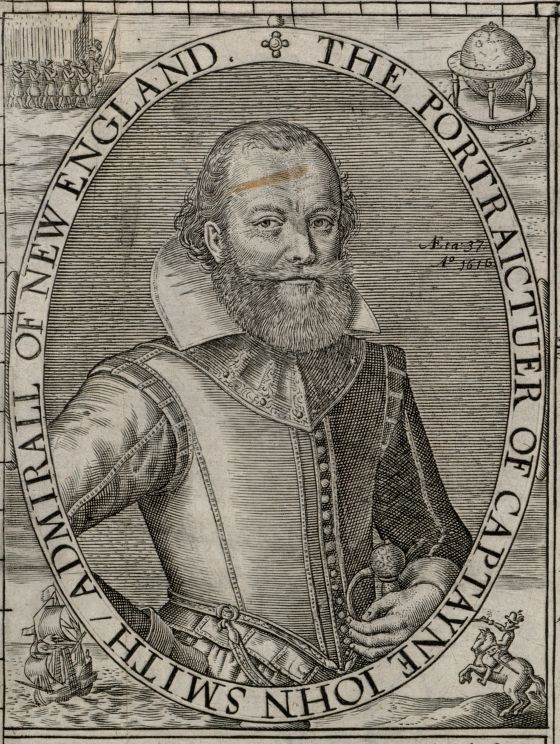Luring Europeans to settle New England
| Title | New England : The Most Remarqueable Parts Thus Named by the High and Mighty Prince Charles, Nowe King of Great Britain |
| Creator | John Smith; Simon van de Pass; James Reeve |
| Year | 1635 |
| Dimensions | 30 × 36 cm |
| Location | Mapping Boston Collection |
When John Smith sailed up the Atlantic coast of North America in 1614, he found a region which he decided, in an act of considerable imaginative fancy, to call “New England”—a name which was calculated to seem like the sort of place that an English emigrant could find familiar. Smith titled himself the “Admiral of New England,” despite having barely left his ship during the trip, and proceeded to publish a book in London in 1616 promoting the region as an ideal site for European settlement. Smith's Description of New England was full of promising tales of natural abundance: it described a landscape “planted with Gardens and Corne fields,” remarked on the “greatnesse” of both timber and fish, praised “the moderate temper of the ayre,” and concluded, “who can but approoue [approve] this a most excellent place, both for health & fertility?” ()
Wander across the exhibition →
The original version of this map was printed for Smith's 1616 book, but it continued to be republished as one of the authoritative maps for English settlers interested in the area—including the Plymouth pilgrims and John Winthrop's Massachusetts Bay Company. Although whatever “Gardens and Corne fields” Smith might have actually seen would have been the work of the Massachusett people, who had inhabited the region for generations, Smith's map gave little evidence of Indian settlement. While this 1624 edition does include a few wigwams on the north bank of the Charles River, these were minor symbols compared to the totally fabricated English place names which were dropped up and down coast—imaginary towns like “Cambridge” near what is today Portland, Maine. European-style villages with churches, houses, and grazing cows are dotted throughout the area, a far cry from the precarious reality of English settlement in the 1620s and 30s.
This map does get one natural resource undoubtedly correct. A teeming mass of fish are shown off the tip of Cape Cod (called Cape James here). Beneath the cod, a caption on this 1635 edition of the map makes reference to another key document that marketed New England to potential settlers. “He that desyres to know more of the Estate of New England,” it notes, “lett him read a new Book of the prospecte of new England & ther he shall haue Satisfaction.” The suggestion refers to William Wood's book New Englands Prospect, published just a year before this edition of the map, which was one of the first thorough geographical descriptions of New England for English audiences. In the introduction to that book, Wood insisted on his own reliability: “I have laid down the nature of the Country,” he wrote, “without any partiall respect unto it […] my conscience is to me a a thousand witnesses, that what I speak is the very truth.” ()
Like many official documents of the time, this map puffed up its royal sponsors, with a title dedicated to “the high and mighty Prince Charles,” who by this edition had become the King of England. The name of the Charles River was meant to flatter Charles, as well, during a time when Smith was seeking to convince the king to sponsor his proposed military expeditions. Smith died in 1631, four years before this version of the map was published, and, perhaps in commemoration of the deceased adventurer, this map features an amusing piece of personal distortion. Compared to the earlier editions, John Smith's portrait here has been embellished with a richer, fuller beard.
Bibliography
- Smith 1616
- John Smith, A Description of New England (1616). Paul Royster, ed., Electronic Texts in American Studies 4. https://digitalcommons.unl.edu/etas/4
- Wood 1634
- William Wood, New Englands Prospect (London: John Bellamie, 1634). Reprinted 1898. https://hdl.handle.net/2027/uc2.ark:/13960/t78s4z819

